[ad_1]
Relating to fashionable TV screens, there are two panel and lighting combos that stand triumphantly above the remainder — QLED and OLED. The previous is championed by manufacturers like Samsung, Hisense, and TCL, whereas the latter has been a standout show model for LG, one of many go-to suppliers of OLED panels for quite a few manufacturers, together with Sony, Philips, and Panasonic. However in terms of how your TV is lit, how good its colours and distinction are, and what worth you possibly can count on to pay, is there a greater choice between the 2 applied sciences?
On this in-depth explainer, we’ll talk about QLED versus OLED, the place these competing show applied sciences come from, how they’re completely different from one another, and what every one does properly (and never so properly). We’ll additionally share which one we expect most individuals can be happiest with. Spoiler: it’s OLED TV — however with a number of caveats you want to pay attention to.
When you’ve settled on which TV tech is best for you, try among the finest QLED TV offers and the finest OLED gross sales out there now.
What’s QLED?
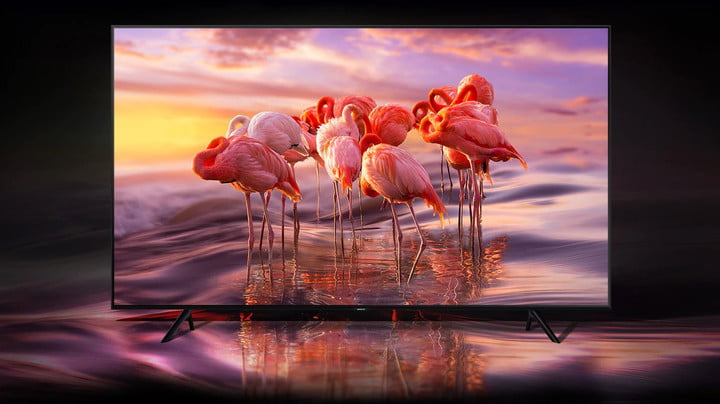
QLED stands for Quantum Mild-Emitting Diode. In non-geek-speak, meaning a QLED TV is rather like an everyday LED TV, besides it makes use of tiny nanoparticles referred to as quantum dots to super-charge its brightness and shade. The expertise was launched by Sony in 2013, however shortly after that, Samsung started promoting its QLED TVs and established a licensing partnership with different producers, which is why you’ll additionally discover QLED TVs from Vizio, Hisense, TCL, and lots of small manufacturers too.
How do quantum dots work? Take a look at our deep dive into the expertise for the entire particulars.
As cool as quantum dots are, a QLED TV nonetheless produces gentle roughly the identical means as an everyday LED TV: Through the use of a backlight made up of a whole lot (or in some circumstances hundreds) of LEDs, which sits behind a conventional LCD panel. It’s these LEDs that give LED (and QLED) its title.
Curiously, it’s this use of QLED as a advertising time period that began a warfare between LG and Samsung in 2019. In a criticism to South Korea’s Truthful Commerce Fee (FTC), LG claimed that Samsung’s so-called QLED TVs aren’t actual QLED TVs in any respect. That’s as a result of, in response to LG, a real QLED TV would use quantum-dot LEDs that emit their very own gentle, and never the quantum-dot-film-over-an-LED-backlight that Samsung makes use of.
In a retaliatory transfer, Samsung instructed the FTC it was sad with the entire advertisements LG had been working, which attacked Samsung’s QLED TVs.
The FTC finally took Samsung’s facet, however with a stipulation: it should make it clear in future ads that its QLED TVs use a backlight. Particulars, particulars.
The LCD panel — basically thousands and thousands of tiny shutters that open and shut too rapidly to see — at the side of the colour filters create the image you see by letting simply the correct amount of sunshine and shade escape and attain your eyes. It’s a intelligent system, but it surely depends on a mixture of dimming the LED backlights and utilizing the shutters to dam the remaining gentle to supply correct on-screen blacks, and it doesn’t all the time succeed. We’ll talk about this extra under.
What’s OLED?

OLED stands for Natural Mild-Emitting Diode. Considerably surprisingly, the “Mild Emitting-Diode” a part of that title has nothing to do with an LED backlight. As a substitute, it refers to the truth that each single particular person pixel in an OLED set can also be a teeny, tiny LED gentle — however one that’s extremely skinny and might produce each gentle and shade in a single factor. In different phrases, OLED TVs don’t want a backlight as a result of every OLED pixel produces its personal gentle. If you wish to impress your pals, you should use the trade phrases for these sorts of shows: emissive or self-emissive.
There are a number of benefits to this design, however most would agree that in terms of OLED TVs, the most important benefit is the excellent black stage that may be achieved. Not like a QLED or LED TV that should dim its backlight and block what stays for darkish scenes, an OLED TV merely turns off the pixel. When the pixel is off, it emits no gentle and no shade, making it as darkish as when the TV itself is turned off.
Just one firm makes OLED TV panels: LG Show. It sells these panels to its sister firm, LG Electronics, which makes use of them to construct among the absolute best TVs you should purchase. However LG Show additionally sells OLED panels to corporations like Sony, Vizio, Philips, and Panasonic, which is why you’ll see OLED televisions from these corporations, too. Although the panels themselves are basically similar, the picture processing that Sony, LG, and others do is proprietary, so that you’ll nonetheless see variations in image high quality from one OLED TV to a different.
What’s Mini-LED?
As you learn up in your new TV choices, you may see some merchandise touting Mini-LED expertise. It might sound like a competitor to QLED and OLED, but it surely’s truly simply an enchancment of LED backlighting utilized by QLED and LED TVs.
Mini-LEDs are tiny when in comparison with common LEDs. Which means a QLED TV that might usually accommodate a whole lot of LEDs can now accommodate tens of hundreds of Mini-LEDs. The consequence? Far more management over backlighting, resulting in black ranges that come far nearer to OLED than any non-OLED show has ever achieved.
In late 2019, TCL began promoting the 8-Collection, the very first QLED TVs powered by a Mini-LED backlighting system.
For 2022, Mini-LED is now mainstream. Along with TCL, you’ll discover Mini-LED TVs from Samsung (below its “Neo QLED” moniker), LG (which manufacturers these fashions as “QNED“), and Sony, which claims that its Mini-LED TVs are superior to all others because of its unique backlight management expertise.
QLED versus OLED: Which expertise is healthier?
Now that what all these letters stand for and what they imply when it comes to show expertise, let’s evaluate QLED to OLED within the classes that matter most when shopping for a TV: Brightness, distinction, viewing angles, and different notable efficiency issues, like response time and lifespan — all vital elements if you’re shelling out massive cash for a brand new TV.
Black ranges and distinction
Distinction is the distinction between the darkest a part of a picture and the brightest half. If a TV can ship a really black darkish portion, it doesn’t need to make the intense components fairly as shiny to realize good ranges of distinction. That’s why, in terms of black ranges, OLED reigns because the undisputed champion — due to its capacity to go utterly black when it must.
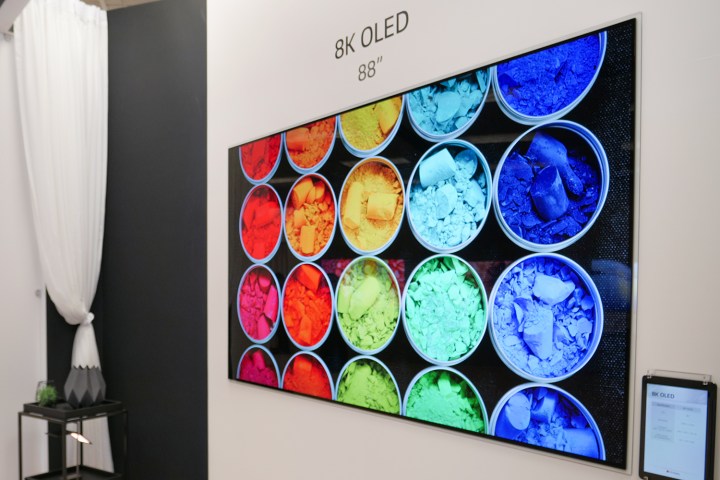
QLED TVs, in contrast (ahem), are compelled to dim their LED backlights and block the remaining gentle, one thing that may be very onerous to do completely. It may set off one thing referred to as “gentle bleed,” as the sunshine spills onto what’s alleged to be a black part of the display.
However is it noticeable? Undoubtedly. In case you’re watching an intense motion film and two characters are working by way of a parking zone at evening, for instance, you could discover a slight glow on components of the scene which are alleged to be pitch black or within the letterbox bars on the high and backside of the display whereas watching a film that makes use of a wider than 16:9 side ratio.
As we highlighted earlier, Mini-LED backlights are a technique QLED TV makers are attempting to enhance this example. It has actual potential, however we’re not fairly able to declare it an OLED killer.
For now, OLED comes out on high. If a pixel isn’t getting electrical energy, it doesn’t produce any gentle and subsequently stays completely black.
Winner: OLED
Brightness
QLED TVs have a substantial benefit in terms of brightness. As a result of they use separate backlights (as an alternative of counting on every pixel to create its personal gentle), these LED backlights might be made extremely, achingly shiny. Add a quantum dot’s capacity to maximise that gentle by producing brighter hues within the shade spectrum with out shedding saturation and also you’ve obtained a show that’s greater than shiny sufficient to be seen clearly in even probably the most brightly lit rooms.
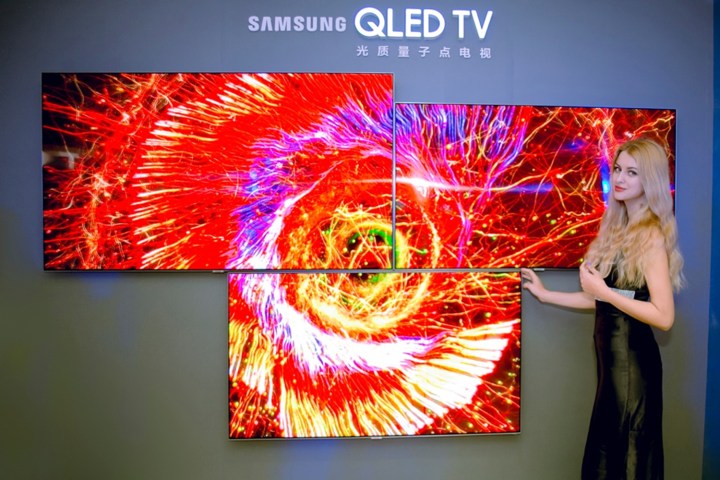
OLED panels can’t compete on a pure brightness foundation. Their light-emitting particular person pixels merely can’t produce the identical quantity of sunshine. In a darkened room, this isn’t an issue. In reality, we’d argue it’s preferable as a result of OLED can obtain the identical distinction with much less brightness, making dark-room viewing a much less retina-searing expertise. However in well-lit environments, or the place plenty of daylight streams in by way of home windows, QLED TVs are extra seen — particularly if you happen to’re enjoying HDR content material below these circumstances.
OLED panels have turn into a lot brighter through the years, however they nonetheless can’t match QLED TVs.
Winner: QLED
Colour area
OLED as soon as blew all of the competitors out of the water on this part, however using quantum dots in QLED TVs has allowed it to inch ahead when it comes to shade accuracy, shade brightness, and shade quantity, in response to Samsung, which claims {that a} wider vary of better-saturated colours at excessive brightness ranges is a bonus.
Whereas there’s no denying the truth that these quantum dot TVs ship incredible colours, now we have but to witness better-saturated colours at excessive brightness ranges ship an actual benefit in regular viewing conditions — so we’re going to declare it a draw for now. We’ll must see some tangible proof to declare QLED a winner.
Winner: Draw
Response time, enter lag, and refresh charge
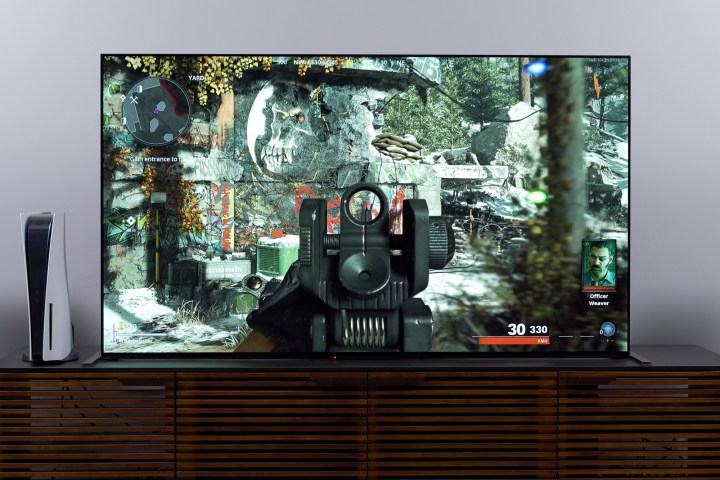
Response time refers back to the time it takes for a pixel to modify from one state to a different. The sooner the response time, the crisper the picture, particularly throughout quick motion scenes. Although there may be seemingly a velocity of response time past which the human eye is incapable of telling a distinction, we all know from standardized measurements that OLED TVs are means sooner — orders of magnitude sooner than QLED TVs.
Typical QLED response instances differ between 2 and eight milliseconds, which sounds fairly good till you understand that OLED’s response time is about 0.1 milliseconds. Yup, it’s no contest.
Enter lag, then again, refers back to the delay between taking an motion (like urgent a button on a sport controller) and seeing the results of that motion onscreen. As such, enter lag is absolutely solely a priority for players — it doesn’t have a noticeable impact on passive viewing of content material in any respect.
Furthermore, the quantity of enter lag you expertise has little to do with one show expertise over one other, however extra to do with how a lot picture processing is going on in your TV behind the scenes. Each QLED and OLED TVs can obtain very low ranges of enter lag if you happen to flip off all additional video processing or just use the TV’s Recreation Mode, which successfully does the identical factor.
Refresh charge is one other class that may inherently matter extra to players than informal viewers. The refresh charge is the variety of instances per second the TV updates what it’s exhibiting onscreen. It’s carefully associated to border charge, which is the variety of instances per second your TV present, film, or online game sends a brand new replace to the TV.
So long as these two charges are shut multiples of one another, e.g. a body charge of 30 frames per second and a refresh charge of double that (60 Hz), you’ll by no means discover an issue. And since common TV content material like films and TV reveals are all the time delivered at constant body charges, that is rarely a priority.
However some video games working on consoles or PCs will change their body charge from one scene to a different. To maintain every thing trying because it ought to, TVs want a characteristic referred to as VRR, or Variable Refresh Charge. This lets your TV alter its native refresh charge to match these adjustments in body charge. In case your TV doesn’t assist VRR, it could possibly trigger some undesirable unwanted effects like display tearing when used with the sorts of video games that require VRR.
Yow will discover VRR fashions in each OLED and QLED TVs. Presently, you will discover VRR TVs from Samsung, Sony, LG, Hisense, and TCL. In case you’re a PC gamer who desires a big-screen gaming expertise, VRR assist is a key characteristic to hunt.
Given OLED’s unbeatable superiority in response time and refresh charge, it owns this class.
Winner: OLED
Viewing angle
With QLED screens, the most effective viewing angle is useless middle, and the image high quality diminishes in brightness, shade, and distinction the additional you progress facet to facet or up and down. Whereas the severity differs between fashions, it’s all the time noticeable — regardless of TV makers’ finest efforts to eradicate the problem.

OLED screens, by comparability, might be seen with no luminance degradation even at drastic viewing angles — as much as 84 levels. Some QLED TVs have improved when it comes to viewing angle, with anti-reflective layers serving to, however OLED maintains a transparent benefit. So if you happen to like to rearrange household screenings of your favourite films and need to be sure there isn’t a foul seat in the home, an OLED TV is finest for you.
Winner: OLED
Measurement
OLEDs have come a great distance. When the tech was nonetheless nascent, OLED screens maxed out at 55 inches. Right now, display sizes as massive as 97 inches are attainable, however solely at nice expense — the $30,000 worth for an 88-inch mannequin places it out of attain for nearly everybody. QLED expertise is less complicated and cheaper to supply at bigger sizes. Samsung’s 85-inch QN800B 8K Neo QLED TV is barely $6,500, whereas its largest shopper mannequin — at 98-inches — prices $15,000.
Winner: QLED
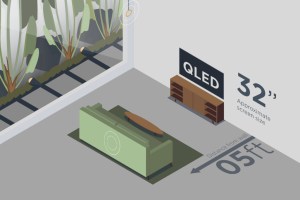
Lifespan
LG says you would need to watch its OLED TVs 5 hours per day for 54 years earlier than they fell to 50% brightness. Whether or not that’s true stays to be seen, as OLED TVs have solely been out within the wild since 2013. QLED is even newer, however its supply of backlighting — the LED — has a protracted and confirmed observe report. For that cause and that cause solely, we’ll award this class to QLED.
Winner (for now): QLED
Display screen burn-in

Each QLED and OLED TVs can often exhibit one thing referred to as picture retention. That is when a TV briefly continues to show a part of a picture after the unique picture has disappeared. It often presents itself as a form of shadow — that’s when it presents itself in any respect.
When picture retention does happen, it’s often the results of having the identical visible factor onscreen for lengthy durations of time. Community logos within the nook of the display have been identified to trigger it, as can video video games that current the identical interface components all through gameplay.
Picture retention usually goes away by itself as soon as you turn to another form of content material that doesn’t present the problematic on-screen components.
Due to their self-emissive nature, OLED TVs are additionally inclined to the a lot rarer everlasting model of picture retention, which is named “burn-in.” Burn-in is brought about when a number of OLED pixels have their regular brightness completely diminished to a decrease state. The one repair for that is to decrease the entire remainder of the pixels to the identical state, however that’s hardly a great resolution.
For an absolute assure that you simply gained’t expertise burn-in, your finest guess is QLED TV.
LG, as the most important maker of OLED TVs, acknowledges the potential for picture retention inside its consumer manuals for its OLED TVs however says that below regular viewing circumstances it shouldn’t occur.
So what constitutes “regular” viewing circumstances? Effectively, for one factor, retaining your TV on the identical channel for 10 hours a day, two months in a row, is outwardly not regular. Certainly one of our readers did this by watching MSNBC on his LG C8 OLED TV, which created what he claims is a burn-in shadow of a portion of the MSNBC peacock emblem and a portion of the “Dwell” graphic that usually accompanies it within the bottom-right nook of the display.
Ought to this scare you away from shopping for an OLED TV? Completely not. However if you happen to’re selecting a TV to be used as a industrial show in a retailer or maybe in a ready room, or if you happen to assume you’ll use it to play the identical online game solely for months at a time, it’s positively one thing to pay attention to.
For an absolute assure that you simply gained’t expertise burn-in, your finest guess is QLED TV.
Winner: QLED
Energy consumption
As you’re now very a lot conscious, OLED panels don’t require a super-bright backlight. These backlights eat a good quantity of energy, which implies OLED TVs are inherently extra energy-efficient. In addition they emit much less warmth than QLED TVs.
Winner: OLED
Eye consolation
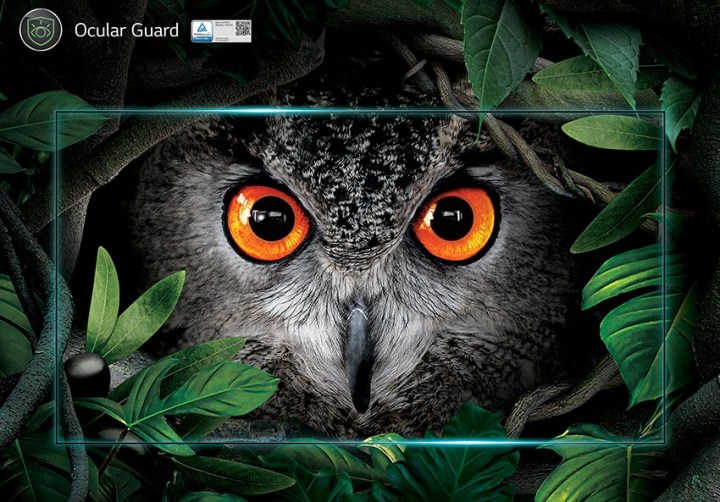
In right this moment’s viewing age, it’s attainable to spend hours looking at TV screens with few breaks in between. Eye fatigue is an actual symptom of the act, and it’s often attributable to extreme blue gentle manufacturing. LCD-based units have a tendency to point out extra intense blue gentle than something, and that is true even in scenes that don’t characteristic gobs of the shade. Go too far, and your irritable eyes might finally result in sleeplessness, which itself can contribute to a complete vary of well being issues. That’s why some OLED makers — most notably LG — are actually looking for Ocular Guard certification for his or her panels.
Created by German security testing agency TÜV Rheinland and beforehand marketed below the less-exciting “Eye Consolation Show” moniker, Ocular Guard certification exams a variety of components in TV panels to find out whether or not they’re too harsh on the eyes.
In concept, OLED TVs ought to provide higher total eye consolation than QLED and some other LCD-based display, as a result of OLED produces considerably much less blue gentle than LED-backlit QLED TVs. It’s nothing a particular pair of glasses can’t deal with, however if you wish to guarantee you’ve got the most secure viewing expertise attainable that doesn’t require buying new glasses, OLED is your champ.
Winner: OLED
Value
As soon as upon a time, this class could be handily gained by QLED TVs, however OLED TVs have come down in price, and since we’re speaking all-premium right here, comparable QLED TVs price about the identical (or extra, relying on the scale). 2022 will see the best variety of OLED-based TVs to this point, and as is all the time the case, when manufacturing numbers go up, costs come down.
In case you’re purchasing round and see QLED TVs for reasonable — and a few of them are extremely inexpensive — remember the fact that, in contrast to OLED TV, there’s a big selection in image high quality with QLED TVs as a result of there are way more variables of their design, image processing, and construct. Solely the very top-of-the-line QLED TVs are equal to OLED in image high quality.
Our winner remains to be QLED, as a result of on a worth per inch of display dimension foundation, it’s nonetheless extra inexpensive, however that hole is getting smaller yearly.
Winner: QLED
QLED versus OLED: The decision
Each of those applied sciences are spectacular in their very own methods, however we’re right here to choose a winner, and for the second, it’s OLED. With higher efficiency within the classes that most individuals will discover whereas watching TV reveals and films, it’s the most effective image high quality you should purchase.
Associated
QLED comes out on high on paper, delivering the next brightness, longer lifespan, bigger display sizes, cheaper price tags, and no threat of burn-in. OLED, then again, has a greater viewing angle, deeper black ranges, makes use of much less energy, is killer for gaming, and could be higher in your well being. Each are incredible, although, so selecting between them is subjective. QLED is the higher all-rounder, however OLED expertise excels when you possibly can management your room’s lighting.
Yet another factor: QD-OLED

OK, so now that we’ve highlighted the variations between QLED and OLED, there’s another factor so that you can contemplate: QD-OLED.
Because the title suggests, QD-OLED is a hybrid of OLED and QLED applied sciences that makes use of OLED materials for its gentle supply and thus retains all of OLED’s benefits however replaces a traditional OLED TV’s shade filter with quantum dots. This creates a stunningly shiny, fantastically colourful, and deeply black show. Curious as to how this works? We now have a deep-dive explainer that covers every thing it is advisable to know.
By way of availability, there are at present two unbelievable QD-OLED TVs in the marketplace, Samsung’s spectacular S95B and Sony’s A95K (each out there in 55- and 65-inch sizes) — the latter being the most effective TV we’ve ever reviewed, interval. And for the gaming fanatics of our readership, there’s additionally the Dell Alienware 34-inch QD-OLED monitor.
Merely put, all three shows provide among the finest brightness, shade, distinction, and movement capabilities you’re going to search out proper now.
Editors’ Suggestions
[ad_2]

